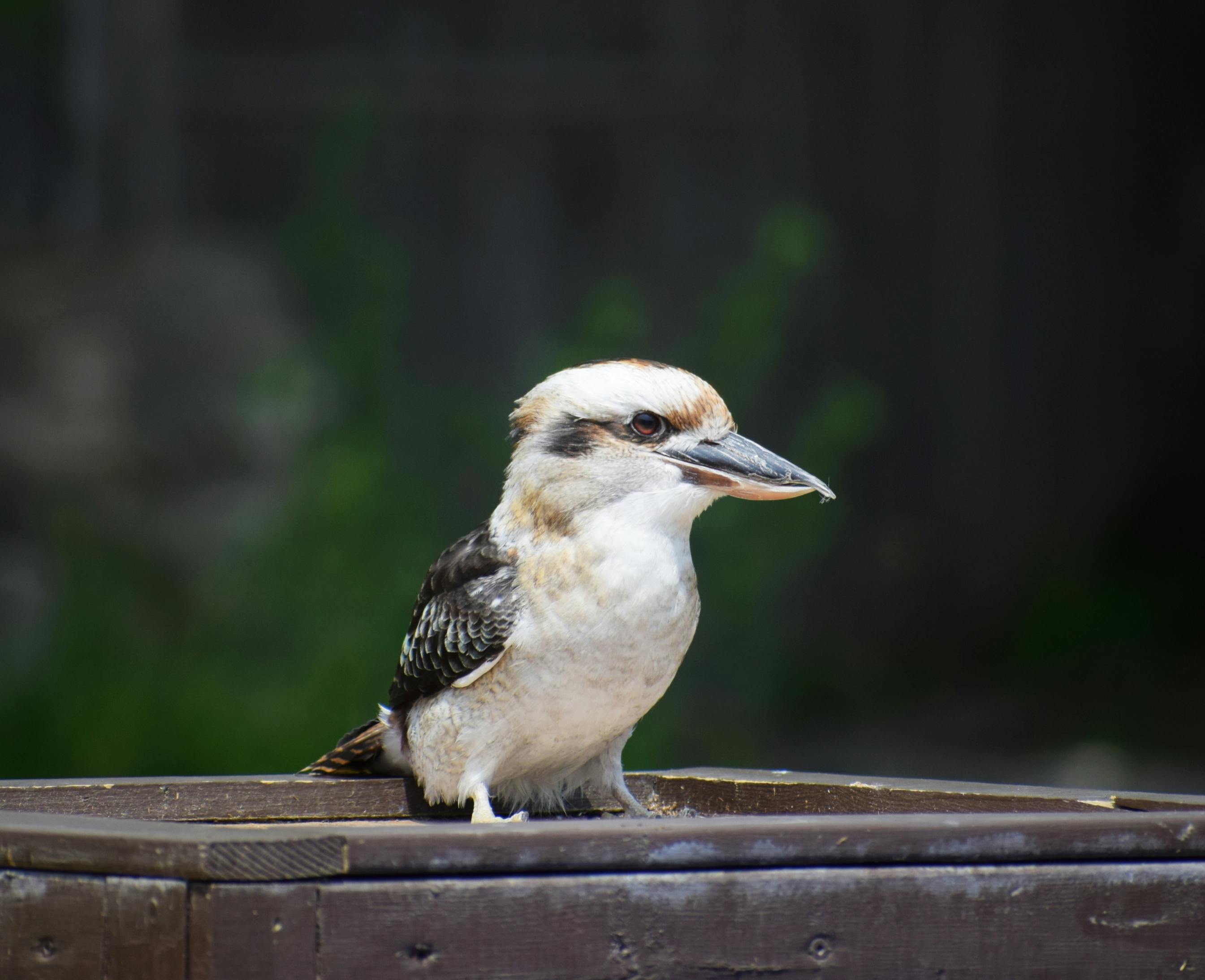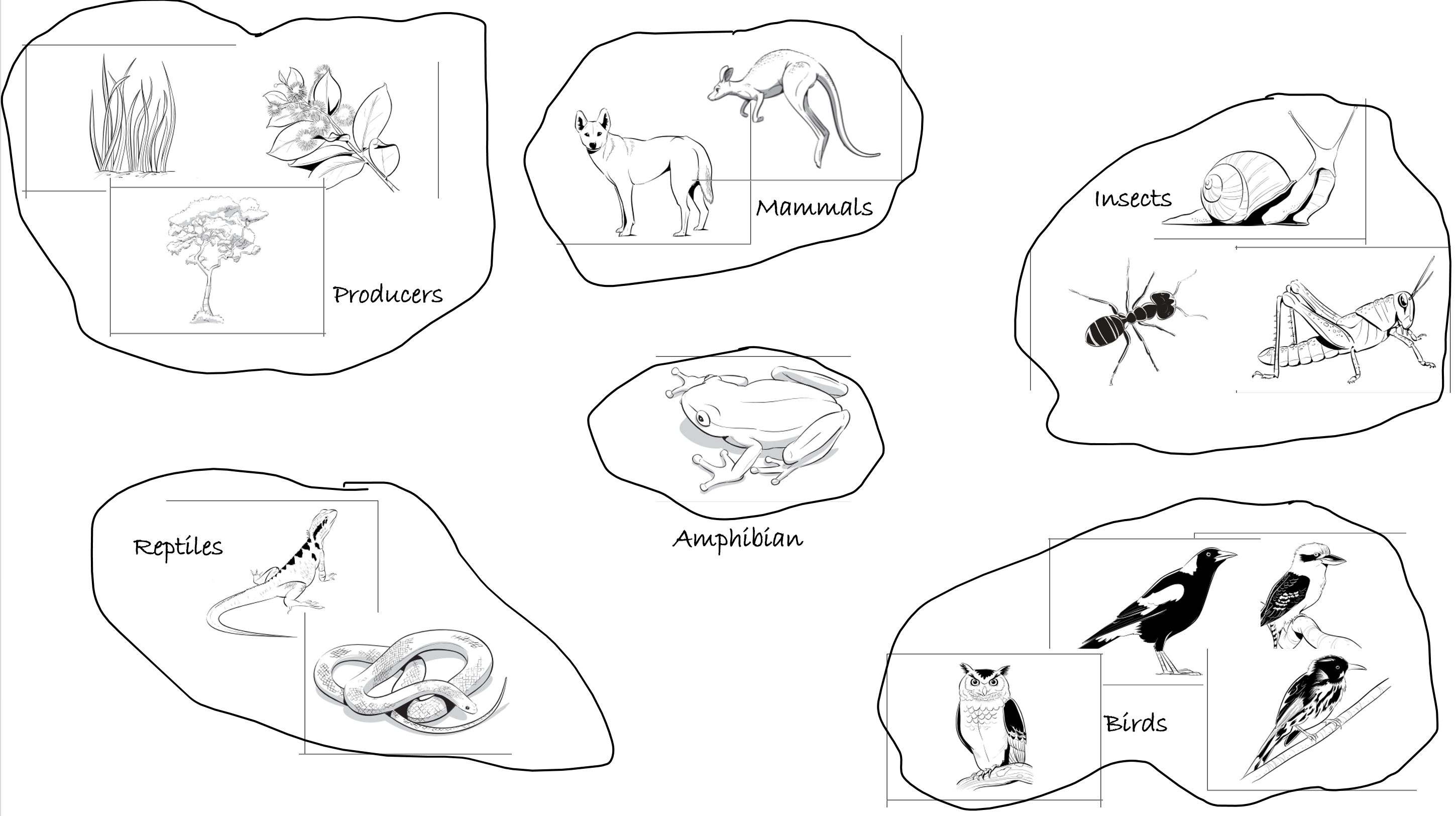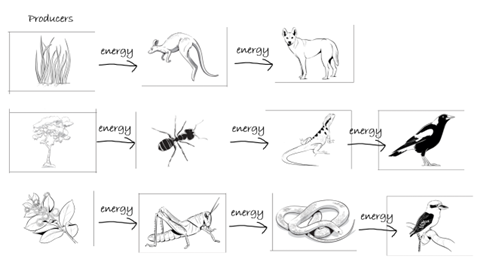Sustain the chain
View Sequence overviewStudents will:
- identify organisms as producers or consumers.
- describe the transfer of energy along a food chain.
Students will represent their understanding as they:
- create a food chain from a selection of plants and animals.
- use arrows to identify the transfer of energy along a food chain.
- describe a food chain in the local environment.
In this lesson, assessment is formative.
Feedback might focus on:
- Are students using the terms producer and consumer appropriately?
- Are students able to describe a food chain in terms of producer and consumer?
- Are students using food chains to describe energy transfer?
- Do all food chains start with a producer?
- Are students identifying links between different food chains?
- Do students identify all organisms in the food chain as important?
- Do students identify consumers as being reliant on producers?
Whole class
Class science journal (digital or hard-copy)
Materials to create a word wall
Demonstration copy of What eats what? Resource sheet
Each student
Individual science journal (digital or hard-copy)
What eats what? Resource sheet
Lesson
The Inquire phase allows students to cycle progressively and with increasing complexity through the key science ideas related to the core concepts. Each Inquire cycle is divided into three teaching and learning routines that allow students to systematically build their knowledge and skills in science and incorporate this into their current understanding of the world.
When designing a teaching sequence, it is important to consider the knowledge and skills that students will need in the final Act phase. Consider what the students already know and identify the steps that need to be taken to reach the level required. How could you facilitate students’ understanding at each step? What investigations could be designed to build the skills at each step?
Read more about using the LIA FrameworkRe-orient
Discuss the classroom context for this teaching sequence. Outline what students have learned so far and how this affects their thinking about the activity they will complete in the Act phase.
Discuss the variety of plants and animals that need to be considered in this context.
The Inquire phase allows students to cycle progressively and with increasing complexity through the key science ideas related to the core concepts. Each Inquire cycle is divided into three teaching and learning routines that allow students to systematically build their knowledge and skills in science and incorporate this into their current understanding of the world.
When designing a teaching sequence, it is important to consider the knowledge and skills that students will need in the final Act phase. Consider what the students already know and identify the steps that need to be taken to reach the level required. How could you facilitate students’ understanding at each step? What investigations could be designed to build the skills at each step?
Read more about using the LIA FrameworkIdentifying and constructing questions is the creative driver of the inquiry process. It allows students to explore what they know and how they know it. During the Inquire phase of the LIA Framework, the Question routine allows for past activities to be reviewed and to set the scene for the investigation that students will undertake. The use of effective questioning techniques can influence students’ view and interpretation of upcoming content, open them to exploration and link to their current interests and science capital.
When designing a teaching sequence, it is important to spend some time considering the mindset of students at the start of each Inquire phase. What do you want students to be thinking about, what do they already know and what is the best way for them to approach the task? What might tap into their curiosity?
Read more about using the LIA FrameworkDiversity is important
Pose the question: How do plants and animals affect each other?
Refer to a student question (if one has been asked) as a jumping off point for the following investigation, relating it to the context being used in this teaching sequence.
Alternative conceptions
What alternative conceptions might students hold about interdependence?

Many students might not recognise the complexity of the relationships between the living things in the school grounds. Some students will understand simple food relationships, such as birds eating worms, but might not consider other relationships, such as how birds also rely on trees to provide shelter.
Many students might not recognise the complexity of the relationships between the living things in the school grounds. Some students will understand simple food relationships, such as birds eating worms, but might not consider other relationships, such as how birds also rely on trees to provide shelter.
The Inquire phase allows students to cycle progressively and with increasing complexity through the key science ideas related to the core concepts. Each Inquire cycle is divided into three teaching and learning routines that allow students to systematically build their knowledge and skills in science and incorporate this into their current understanding of the world.
When designing a teaching sequence, it is important to consider the knowledge and skills that students will need in the final Act phase. Consider what the students already know and identify the steps that need to be taken to reach the level required. How could you facilitate students’ understanding at each step? What investigations could be designed to build the skills at each step?
Read more about using the LIA FrameworkThe Investigate routine provides students with an opportunity to explore the key ideas of science, to plan and conduct an investigation, and to gather and record data. The investigations are designed to systematically develop content knowledge and skills through increasingly complex processes of structured inquiry, guided inquiry and open inquiry approaches. Students are encouraged to process data to identify trends and patterns and link them to the real-world context of the teaching sequence.
When designing a teaching sequence, consider the diagnostic assessment (Launch phase) that identified the alternative conceptions that students held. Are there activities that challenge these ideas and provide openings for discussion? What content knowledge and skills do students need to be able to complete the final (Act phase) task? How could you systematically build these through the investigation routines? Are there opportunities to build students’ understanding and skills in the science inquiry processes through the successive investigations?
Read more about using the LIA FrameworkWho is hungry?
Referring to the demonstration copy of the What eats what? Resource sheet, identify the animals and plants shown.
Ask students if they think there are other living things besides plants and animals, and if they can name any.
Students arrange the images of plants and animals into groups/categories. They can make different types of groups, or sub groups.
Share and discuss the categories students found.
- What groups did you make? What did you call those groups?
- What do the members of each group have in common?
- What other groupings can we make?
- Why do you think scientists group organisms?
- What connections did you make about what eats what?

Discuss food in relation to how it provides energy to animals.
- What's the purpose of eating food?
- Students might discuss the enjoyment they get from eating food, or that it keeps us healthy and gives our body nutrients. These are all acceptable responses. However, try to guide the conversation towards the specific point that food gives animals energy.
- Where do we get our energy from?
- The food we eat.
- Why do we need energy?
- To grow, move, stay alive.
- What might happen if you missed lunch? How would you feel? Why do you think this happens?
- Of the plants and animals we've been looking at, which ones don't ‘eat’ anything else?
- The plants: grass, trees and leaves.
Pose the question: Where do plants get their energy?
At this stage it is not necessary for students to understand the process of photosynthesis, however, students might have some understanding that plants get their energy from the sun, or that, at the very least, they need the sun to grow and survive.
If students are unable to articulate this, present the following claims and ask them if they think each is true or not true, and why:
- Plants need energy from the sun to stay alive.
- Plants need water from the soil and carbon dioxide from the air to stay healthy.
- The sun's energy is used to combine these molecules into sugar which is used to make new leaves.
Remind students of learning about heat in Year 3, specifically:
- how heat energy was transferred from one object to another.
- how this was shown with arrows showing the direction of heat energy moves.
Discuss how their learning about heat energy connects to this lesson.
- When we draw a representation of the transfer of heat energy, what conventions do we use?
- Arrows can show where the energy is coming from and where it is going to.
- How might you show the transfer of heat energy from the sun to a plant?
- How might you show the plant using the energy it gets from the sun to grow new leaves etc.?
Introduce the term ‘producers’ and 'consumers' in the context of the environment. Add these words to the word wall.
In collaborative teams, using the images from the What eats what? Resource sheet, students arrange a series of images in order to show what eats what, and how energy is transferred from one plant/animal to the next. They will:
- identify something that is a producer (does not ‘eat’ anything), and use it to start their chain.
- select an image of an animal that eats this producer (a consumer).
- select an image of an animal that eats this animal.
- and so on, until they believe there is no 'greater' animal.
You might like to model an example to the class if appropriate.
Share and discuss teams’ series of images.
Discuss the movement of energy from one living thing to another living thing, identifying that as each animal eats the one before it, it is gaining energy to enable it to move, generate heat and sound, and grow.
Introduce the phrase ‘food chain’ in the context of following the movement of energy through an environment, and add it to the word wall. Discuss.
- What do all of the food chains start with?
- They all start with a producer.
- How many organisms/consumers are there in your food chain?
- How many consumers could you have in the longest food chain from these organisms?
Students revise their earlier attempts at creating a food chain and add it to their science journals.

Food chains
The purpose of a food chain is to identify the linear movement of energy through organisms.

The purpose of a food chain is to identify the linear movement of energy through organisms. The direction of the energy movement is shown using arrows moving from the organisms being eaten (the source of the energy) to the consumer (the animal doing the eating).
All food chains are simple linear links that start with a producer (usually a plant). The plant is eaten by an herbivore, which in turn is eaten by a carnivore. Often the food chain will end with a decomposer. The sun is not included in a food chain as it is not an organism.
Most food chains are limited to 4-5 organisms. This is because only a small amount of energy is stored in the tissues of each organism. The rest of the energy is transformed into movement, body heat, sound and the energy needed for all the chemical reactions in the body. This means the top consumer does not have more energy than those further down the chain.
Food chains can be joined together to form a larger food web that show the interactions between species. The strength of the relationships in a food web can vary as some connections are more important than others.
The purpose of a food chain is to identify the linear movement of energy through organisms. The direction of the energy movement is shown using arrows moving from the organisms being eaten (the source of the energy) to the consumer (the animal doing the eating).
All food chains are simple linear links that start with a producer (usually a plant). The plant is eaten by an herbivore, which in turn is eaten by a carnivore. Often the food chain will end with a decomposer. The sun is not included in a food chain as it is not an organism.
Most food chains are limited to 4-5 organisms. This is because only a small amount of energy is stored in the tissues of each organism. The rest of the energy is transformed into movement, body heat, sound and the energy needed for all the chemical reactions in the body. This means the top consumer does not have more energy than those further down the chain.
Food chains can be joined together to form a larger food web that show the interactions between species. The strength of the relationships in a food web can vary as some connections are more important than others.
The Inquire phase allows students to cycle progressively and with increasing complexity through the key science ideas related to the core concepts. Each Inquire cycle is divided into three teaching and learning routines that allow students to systematically build their knowledge and skills in science and incorporate this into their current understanding of the world.
When designing a teaching sequence, it is important to consider the knowledge and skills that students will need in the final Act phase. Consider what the students already know and identify the steps that need to be taken to reach the level required. How could you facilitate students’ understanding at each step? What investigations could be designed to build the skills at each step?
Read more about using the LIA FrameworkFollowing an investigation, the Integrate routine provides time and space for data to be evaluated and insights to be synthesized. It reveals new insights, consolidates and refines representations, generalises context and broadens students’ perspectives. It allows student thinking to become visible and opens formative feedback opportunities. It may also lead to further questions being asked, allowing the Inquire phase to start again.
When designing a teaching sequence, consider the diagnostic assessment that was undertaken during the Launch phase. Consider if alternative conceptions could be used as a jumping off point to discussions. How could students represent their learning in a way that would support formative feedback opportunities? Could small summative assessment occur at different stages in the teaching sequence?
Read more about using the LIA FrameworkLocal food chains
Review the Scientific field notes from Lesson 2 and:
- identify the plant/animal that was observed in the selected context.
- identify organisms that might come before and after it in a food chain, thus creating a food chain relevant to the selected context.
- identify and label the producer and consumer in this 'local' food chain.
Discuss how this food chain might be interrupted.
- What would happen if one of the producers were removed from this chain?
- If we change something/build something new in (selected context location) how might we disturb the habitats of the plants and already living there?
- What can we do to make sure we conserve or replace the producers/homes/shelters if we disturb them?
Reflect on the lesson
You might:
- review the new words learned during this lesson: producer, consumer, food chain.
- update the TWLH chart by inviting students to add what they have learned (L) and the evidence/observations that show how (H) they now know that.